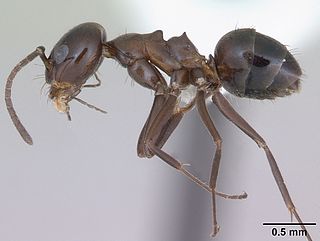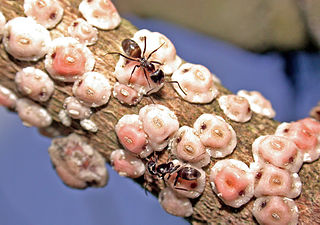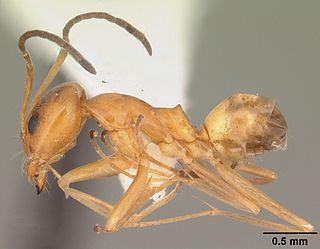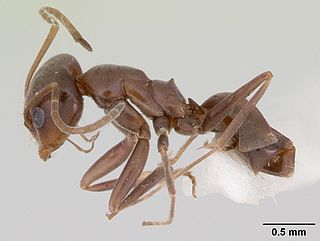
Arnoldius flavus is a species of ant of the genus Arnoldius, one of only three species described in it. Native to Australia, it was described by Crawley in 1922.
Dorymyrmex antarcticus is a species of ant in the genus Dorymyrmex. Described by Forel in 1904, the species is endemic to Argentina and Chile.
Dorymyrmex baeri is a species of ant in the genus Dorymyrmex. Described by André in 1903, the species is endemic to Argentina.

Dorymyrmex biconis is a species of ant in the genus Dorymyrmex. Described by Forel in 1912, the species is endemic to Colombia and Venezuela.

Dorymyrmex bituber is a species of ant in the genus Dorymyrmex. Described by Santschi in 1916, the species is endemic to Argentina and Paraguay.
Dorymyrmex breviscapis is a species of ant in the genus Dorymyrmex. Described by Forel in 1912, the species is endemic to Argentina.

Dorymyrmex brunneus is a species of ant in the genus Dorymyrmex. Described by Forel in 1908, the species is endemic to several nations in South America.

Dorymyrmex bureni also known as pyramid ant is a species of ant in the genus Dorymyrmex. Described by Trager in 1988, the species is endemic to the United States and Mexico. Pyramid ants are medium-sized ants, ranging from 2–4 mm. They are light orange in color and fast moving. Unlike other ants in the area like red imported fire ants, this species is not aggressive towards humans. The workers have a foul smelling coconut odor when crushed. Dorymyrmex bureni hunt living insects, even other winged ants. They also search for sap-sucking insects from which they collect honeydew. On the head of these ants are curved hairs, used for transporting beads of damp sand. Colonies are small. Nests usually have a single entrance with a mound of sand shaped like a crater. Dorymyrmex bureni prefer sandy soil. This species of ant is not an indoor pest, and pesticides should not be used. They are found throughout Florida.
Dorymyrmex carettei is a species of ant in the genus Dorymyrmex. Described by Forel in 1913, the species is endemic to Argentina.
Dorymyrmex caretteoides is a species of ant in the genus Dorymyrmex. Described by Forel in 1914, the species is endemic to Argentina.
Dorymyrmex chilensis is a species of ant in the genus Dorymyrmex. Described by Forel in 1911, the species is endemic to Chile.
Dorymyrmex coniculus is a species of ant in the genus Dorymyrmex. Described by Santschi in 1922, the species is endemic to Argentina.

Dorymyrmex elegans is a species of ant in the genus Dorymyrmex. Described by Trager in 1988, the species is endemic to the United States and Mexico, where it is a nocturnal species and is normally seen on cool days.
Dorymyrmex goetschi is a species of ant in the genus Dorymyrmex. Described by Goetsch in 1933, the species is endemic to Chile.
Dorymyrmex minutus is a species of ant in the genus Dorymyrmex. Described by Emery in 1895, the species is endemic to Argentina and Chile
Dorymyrmex morenoi is a species of ant in the genus Dorymyrmex. Described by Bruch in 1921, the species is endemic to Argentina.

Dorymyrmex smithi is a species of ant in the genus Dorymyrmex. Described by Cole in 1936, the species is endemic to the United States and Mexico.









